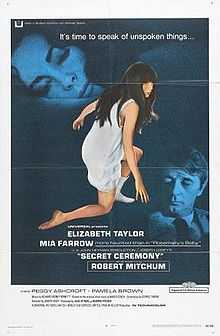Secret Ceremony
| Secret Ceremony | |
|---|---|
 | |
| Directed by | Joseph Losey |
| Produced by |
John Heyman Norman Priggen |
| Written by | George Tabori |
| Starring |
Elizabeth Taylor Mia Farrow Robert Mitchum |
| Music by | Richard Rodney Bennett |
| Cinematography | Gerry Fisher |
| Editing by | Reginald Beck |
| Distributed by | Universal Pictures |
| Release dates | 1968 |
| Running time | 105 min. |
| Country | United Kingdom |
| Language | English |
| Budget | $2,450,000[1] |
| Box office | $3 million (US/ Canada rentals)[2] |
Secret Ceremony is a 1968 film, produced in Britain and released by Universal Pictures. Based on the book by Argentine writer Marco Denevi, it stars Elizabeth Taylor, Mia Farrow, Robert Mitchum, Pamela Brown, and Peggy Ashcroft. Joseph Losey directed, from a script by George Tabori.
Plot
Leonora, a prostitute, is despondent over the death of her daughter. Cenci, a lonely young woman, is immediately attracted to Leonora and practically adopts her as her mother.
Cenci's stepfather, Albert, intrudes into this make-believe mother and daughter relationship, and tragedy ensues.
Reception
Critics
Critical reception of the film has tended to be mixed, with some critics essentially maintaining that it is a bad film but yet one that can be enjoyed due to a certain camp quality evident in Losey's mise-en-scène and the actors' performances. However, other film analysts regard the film as compelling because of its deep psychological portraits. Taylor's performance has been characterized as occasionally tacky, but justified by the fact that she is playing a prostitute and mother at the same time. Fans of the film cite its many moments of heart-rending emotional truth in the character, which Taylor conveys effortlessly. The role has been called one of her best ever. Farrow's performance is referred to by fans as outstanding, and Mitchum as the perverted stepfather has been described as nothing short of searing.
The chief set of the film, the house where Farrow lives, was Debenham House in London's Holland Park district. The house is a noted example of the Arts and Crafts style. Losey was famous for his so-called baroque style which he put to full use showing off the architecture of the set. For the scenes on the beach Losey chose a spot in Noordwijk, the Netherlands.
There are apparently varying versions of the film, the result of Universal Pictures' tampering with Losey's original cut, possibly to de-emphasize the lesbian aspects of the Taylor-Farrow relationship. Writer Harlan Ellison has noted in many articles that Universal Studios executives tend to savage their own films to the point of vandalism.
Cast
- Elizabeth Taylor as Leonora
- Mia Farrow as Cenci
- Robert Mitchum as Albert
- Peggy Ashcroft as Hannah
References
External links
| |||||